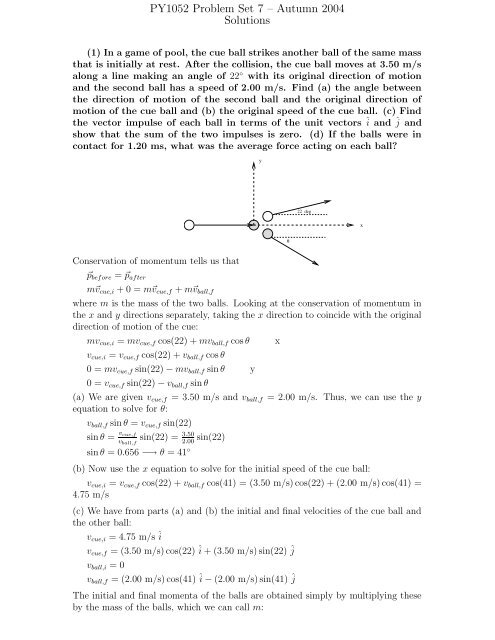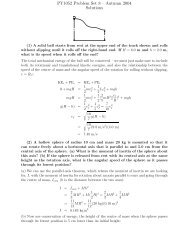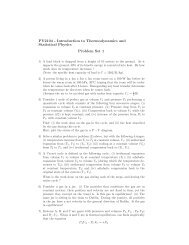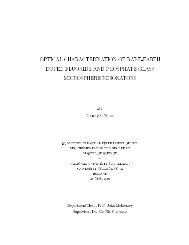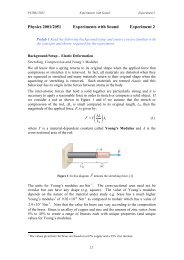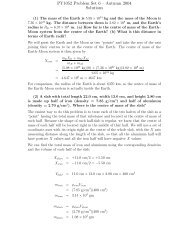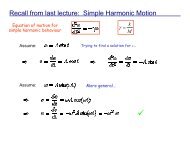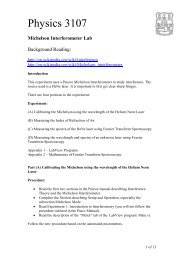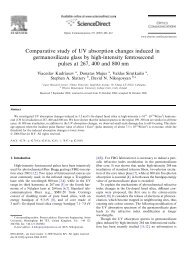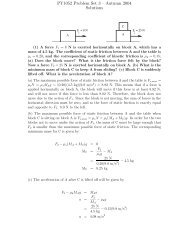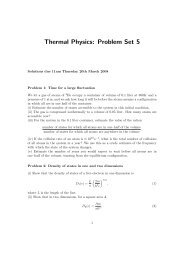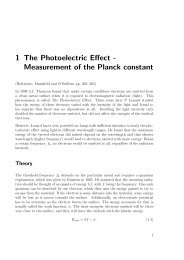PY1052 Problem Set 7 â Autumn 2004 Solutions
PY1052 Problem Set 7 â Autumn 2004 Solutions
PY1052 Problem Set 7 â Autumn 2004 Solutions
Create successful ePaper yourself
Turn your PDF publications into a flip-book with our unique Google optimized e-Paper software.
p cue,i = 4.75m kg m/s îp cue,f = 3.24m kg m/s î + 1.31m kg m/s ĵp ball,i = 0p ball,f = 1.51m kg m/s î − 1.31m kg m/s ĵThe impulses of the two balls are:J cue = p cue,f − p cue,i = (3.24m − 4.75m) kg m/s î + 1.31m kg m/s ĵJ cue = −1.51m kg m/s î + 1.31m kg m/s ĵJ ball = p ball,f − p ball,i = 1.51m kg m/s î − 1.31m kg m/s ĵWe can immediately see that the sum of the two impulses is zero:J cue + J ball = (−1.51m + 1.51m) kg m/s î + (1.31m − 1.31m) kg m/s ĵ = 0(d) The magnitude of the impulse acting on each ball is given byJ = √ √Jx 2 + Jy 2 = (1.51m kg m/s) 2 + (1.31m kg m/s) 2 = 2.00m kg m/sTherefore, the average force acting on the ball isJ = F avg ∆t −→ F avg = J/∆t2.00m kg m/sF avg =1.20×10 −3 s = 1667m N(2) A ball having a mass of 150 g strikes a wall with a speed of 5.2 m/sand rebounds with only 50% of its initial kinetic energy. (a) What is thespeed of the ball just after it leaves the wall? (b) What is the impulse onthe ball due to the wall? (c) What is the impulse on the wall due to theball? (d) If the ball is in contact with the wall for 7.6 ms, what was theaverage force on the ball from the wall during the collision?(a) KE f = 1 2 mv2 f = 1 2 KE i = 1 2 [ 1 2 mv2 i ]v 2 f = 1 2 v2 iv f = −v i / √ 2 = −5.2 m/s/ √ 2 = −3.68 m/swhere there is a negative sign in front of v f because the direction of v f is opposite tothat of v i .(b) The impulse is thereforeJ = p f − p i = mv f − mv i = m(− √ v i2− v i ) = −m( √ v i2+ v i )J = −(0.150 kg)(3.68 m/s + 5.20 m/s) = −1.34 kg m/sThe magnitude of the impulse of the ball due to the wall is 1.34 kg m/s, and theimpulse is directed in the negative direction, which is away from the wall.(c) Because of Newton’s Third Law, the impulse of the wall due to the ball is equaland opposite to the impulse of the ball due to the wall – +1.34 kg m/s.(d) If the ball is in contact with the wall for 7.6 ms, the average force on the ball isF avg = J ∆t = −1.34 kg m/s0.0076 s = 1.76 × 103 N(3) A railroad car moves at a constant speed of 3.20 m/s under a grainelevator. Grain drops into the car at a rate of 540 kg/min. (a) What is themagnitude of the force that is needed to keep the car moving at constantspeed if friction is negligible? (b) What would be the initial accelerationof the car when the grain began to drop in if this force were not applied(a) Newton’s second law taking into account the possibility of varying mass isF = dp = m dv + v dm dt dt dtSince dm is positive (mass is being added to the car), we see that dv will be negativedtdtin the absence of other forces (F = 0) and the car will slow down. Since the speed isconstant, dv = 0, and the required force isdt
F = v dm dtSince the rate of change of the mass is dm = 540 kg/min = 9.00 kg/s:dtF = v dm = (3.20 m/s)(9.00 kg/s) = 28.8 Ndt(b) If this force is not applied,∑ F = 0 = vdmdv= − v dmdt m dtdt+ m dvdtdv 3.20 m/s= − (9.0 kg/s) = 28.8dt m mm/s2where m is the mass of the railroad car at the initial time.(4) The speed with which cheetahs can run has been measured by observersdriving along with the cheetahs in Jeeps. Imagine trying to measurea cheetah’s speed by keeping your Jeep even with the cheetah whilealso glancing from time to time at your speedometer, which is registering114 km/hr. You keep the Jeep at a constant 8.0 m from the cheetah, butthe cheetah keeps veering away from the Jeep and ends up moving in acircular arc with a radius of 92 m. Since you maintain the Jeep at a distanceof 8.0 m from the cheetah, the radius of the circular arc along whichyou drive is 100 m. (a) What is the angular speed of you and the cheetaharound the circular arcs? (b) What is the linear speed of the cheetah alongits path?(a) The angular speed of the jeep (and cheetah) is given byv = rω −→ ω = v rThe jeep’s speed is114 km × 1000 m × 1 hrhr 1 km 3600 sTherefore= 31.7 m/sω = v = 0.317 rad/sr(b) The linear speed of the cheetah is then given by=31.7 m/s100 mv = rω = (92 m)(0.317 rad/s) = 29.1 m/s = 105 km/hr.When the running speeds of cheetah’s were first estimated in precisely this way, theresearchers involved forgot to take account of the fact that the circle in which thecheetah was running was smaller than the one along which the jeep was driving, sothat these first cheetah speeds were overestimated (the claimed speeds were 114 km/hrrather than 105 km/hr)!(5) What is the moment of inertia of a metre stick with a mass of 0.56 kgabout an axis perpendicular to the stick going through its center (treatthe metre stick like a thin rod)? Using the parallel-axis theorem, calculatethe moment of inertia of the metre stick about an axis perpendicular tothe stick and located at the 20 cm mark.The moment of inertia of the metre stick for rotation about an axis going through itscentre is given by (“thin rod about axis through centre perpendicular to length”):I mid = 1 12 ML2where M is the mass of the metre stick and L is its length (1 m):I mid = 1 12 (0.56 kg)(1.0 m)2 = 0.047 kg m/sThe parallel axis theorem says:I = I com + Mh 2
where I com is the moment of inertia for rotation about an axis that is parallel to theone in which we are interested and passes through the centre of mass, and h is thedistance between the COM axis and our axis. In our case, I com is just equal to I mid ,since the axis for I mid is parallel to the one we are considering and passes throughthe metre stick’s centre of mass. The distance h is just equal to the distance betweenthe middle of the metre stick (the 0.50 m mark) and our axis (the 0.20 m mark), or0.30 m. Therefore:I = I com + Mh 2 = 0.047 kg m/s + (0.56 kg)(0.30 m) 2 = 0.097 kg m/s(6) A delivery truck operates by using the energy stored in a rotatingflywheel, which is a solid cylindre with a mass of 500 kg and a radius of1.0 m. The truck is charged by using an electric motor to get the flywheelup to its top speed of 200π rad/s. (a) What is the kinetic energy of theflywheel after charging? (b) If the truck operates with an average powerrequirement of 8.0 kW, for how many minutes can it operate betweenchargings (1 W = 1 Watt = 1 J/s)?(a) The kinetic energy of rotation of the flywheel isKE = 1 2 Iω2We know that ω = 200π rad/s, and must determine the moment of inertia I of theflywheel to find its kinetic energy. Your table indicates that the moment of inertia ofa solid cylinder or disk about its central axis isI = 1 2 MR2 = 1 2 (500 kg)(1.0 m)2 = 250 kg m/sTherefore, the kinetic energy isKE = 1 2 (250 kg m/s)(200π rad/s)2 = 4.93 × 10 7 J(b) The average power is given byP avg = WorktimeHere, the work done between when the wheel is fully charged (rotating at its maximumangular speed) and uncharged (when it no longer rotates) is equal to the change inthe wheel’s kinetic energy. The time is what we are looking for. Thereforetime = KEP avg= 4.93×107 J8.0×10 3 W = 6.16 × 103 s = 103 min(7) A thin spherical shell has a radius of 1.90 m. An applied torqueof 960 N m gives the shell an angular acceleration of 6.20 rad/s 2 about anaxis passing through the centre of the shell. (a) What is the moment ofinertia of the shell? (b) What is the mass of the shell?(a) You can find from a table of moments of inertia that the moment of inertia of athin spherical shell about any diameter isI = 2 3 MR2but in this situation, we can’t use this directly, because we don’t know the mass ofthe shell. Instead, use Newton’s second law for rotation:τ = Iα −→ I = τ αI =960 N m = 155 kg m/s6.20 rad/s 2(b) Now, using the expression for I for a spherical shell and the answer to (a), wecan find the shell’s mass:I = 2 3 MR2M = 3I2R 2=3(155 kg m/s2(1.90 m) 2 = 64.4 kg
(1b) A 6100 kg rocket is set for vertical firing from the ground. If theexhaust speed is 1200 m/s, how much gas must be ejected each second ifthe thrust is to (a) equal the magnitude of the gravitation force on therocket and (b) give the rocket an initial upward acceleration of 21 m/s 2 ?(a) The thrust is given by Rv rel , where R is the rate at which the fuel is consumedand v rel is the velocity of the rocket relative to the ejected gases. In order for thethrust to be equal to the gravitational force on the rocket,Rv rel = Mg −→ R = Mgv relR = (6100 kg)(9.8 m/s2 )1200 m/s= 50 kg/s(b) In order for the rocket to have an upward acceleration of 21 m/s 2 ,Thrust − Mg = Ma −→ Thrust = M(g + a)Rv rel = M(g + a)R = M(g+a)v relR = (6100 kg)((9.8+21) m/s2 )1200 m/s= 156 kg/s(2b) A pulsar is a rapidly rotating neutron star that emits a radio beamin much the same way that a lighthouse emits a light beam. We receivea radio pulse once each time the star rotates, and we can measure theperiod T of the rotation by measuring the time between the pulses. Thepulsar in the Crab Nebula has a period of rotation of T = 0.033 s, and thisperiod is increasing at a rate of 1.2 × 10 −5 s/year. (a) What is the pulsar’sangular acceleration? (b) The pulsar was born in a supernova explosionseen in the year 1054. What was the initial period T of the pulsar if itsangular acceleration has been constant since the time it was born?The relationship between the period and angular velocity isT = 2π = ω2πω−1Taking the time derivative of both sides:dTdtdω= −2πω−2= dt −2πω−2 α−2 dT= −2πTα = − ω2 dT2π dtdtWe are given that T = 0.033 s and dT/dt = 1.2 × 10 −5 s/year:dTdtTherefore,s= 1.2 × 10−5 × 1 year × 1 day × 3600 s = 3.8 × 10 −13 s/syear 365.25 days 24 hrs 1 hrα = −2π(0.033 s) −2 (3.8 × 10 −13 s/s) = −2.2 × 10 −9 rad/s 2The negative sign indicates that the ω is decreasing, which makes sense because theperiod is increasing.(b) If the angular acceleration is constant, dT/dt is constant. There are 949 yearsbetween 1054 and 2003, soT 2003 = T 1054 + dTdt ∆t −→ T 1054 = T 2003 − dTdt ∆tT 1054 = 0.033 s − (1.2 × 10 −5 s/year)(949 years) = 0.033 s − 0.011 s = 0.022 s


